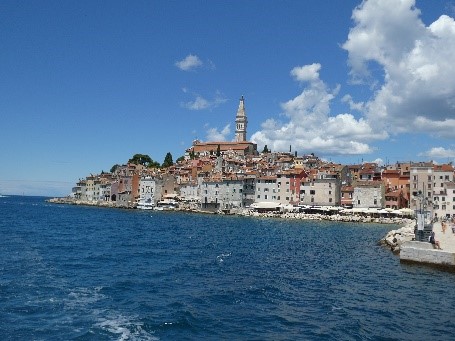At dawn we started our journey to Vrsar . We made our first stop in Graz to collect our classmates.
After leaving the cities behind us, we drove further south through the fertile Austrian countryside. The dense forests are punctuated by smaller villages whose red tiled roofs glittered in the sun. Here and there we also saw vineyards clinging to the hills, a testament to the country's rich wine culture.
We soon reached the border with Slovenia and the landscape changed again. We drove through scenic regions known for their rolling hills and dense forests. The streets are characterized by tall cypress trees, and occasionally we passed small, historic towns with narrow streets and stone houses.
When we finally crossed the border into Croatia, we entered the Istria region, known for its olive groves and vineyards. Small villages with their typical white stone houses and red roofs kept appearing, each with its own unique charm.
Our destination, the coastal village of Vrsar, was getting closer. We drove the last few kilometers along the coast with a spectacular view of the sparkling sea. Vrsar itself welcomed us with its charming, narrow streets and the historic town center. The houses, many built of light stone, have colorful shutters and flowering gardens.
After getting off the bus we took a walk along the seafront. It was the perfect end to a long bus ride.
On Tuesday July 2nd we arrived in the beautiful town of Rovinj boat trip . And this is where we encountered our first problem: our city guide couldn't be found. As it turned out, she was waiting for another ship on the other side of town. After a quick call and a two-minute wait, this hurdle was overcome.
We started the tour and our path led us directly into the branching streets, where you could clearly see from the cobblestones what kind of tourist activity there is. We stopped to look at the remains of the old city wall. Rovinj used to be very well protected and even had a double city wall, of which only remains remain today.
On our way to reach the large church at the top of the city, we passed many other interesting points and monuments, including stones built into the house wall. And we learned about the legend about the city's patron saint: Eufemia. She came from a foreign country where she advocated the Christian religion. For this she was sentenced to death and died, although her coffin was sent across the sea on a raft. The destination was southern Italy, which she never reached. Because one night there was a strong storm and the raft broke. That night a little boy had a dream about this very scene and when he learned in the morning that the story had really happened as in his dream, he dragged the coffin with two oxen up the mountain to the place where he is standing now. Since then she has been the patron saint and her coffin is opened every year on September 16th and visitors can view her body.
Our route took us through the city back towards the harbor. From there we had an hour at our leisure.
Fun Facts: Rovinj has had different rulers: Italy, the Habsburg Empire and Yugoslavia. Through all these phases, the city has continued to develop to this day. The name Rovinj comes from the word ruin. The city is said to have once sunk when sea levels rose, and when the city reemerged only ruins were visible.










